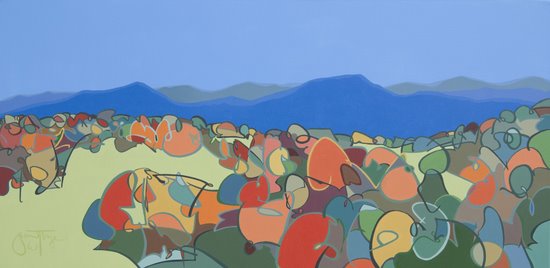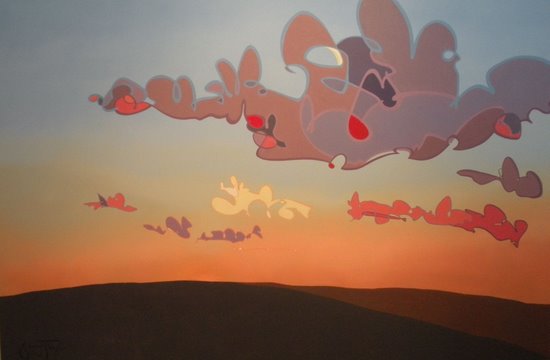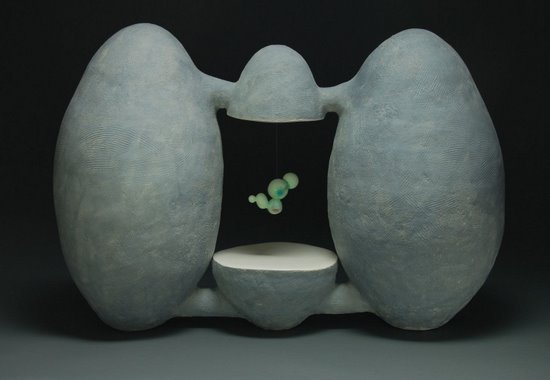I've never seen trees like Grant William Thye's before. The textural and layered brushstrokes commonly used in rendering trees are replaced by bright, flat, organic shapes outlined in calligraphic swooshes. The result is a fresh approach to the genre that's part classical landscape, part abstraction, and part cartoon.
This freshness and presence of a clear style are apparent with all three artists on display through February 28 in Quad City Arts' gallery at the Quad City International Airport. Thye, Angela Dieffenbach, and Karina Cutler-Lake employ traditional genres as vehicles for novel imagery.
Thye utilizes a contemporary painter's style to approach the time-tested landscape. He appears to be more interested in shape, line, repetition, and contrast than the literal trees, fields, and sky commonly associated with the genre.
He presents a contrast between realistic sky and abstracted foreground shapes in Autumn in the Blue Ridge. This painting shows a forest of trees with expansive sky and mountains in the distance. The bottom half of the composition explodes with repeating oval-like shapes in red, green, yellow, blue, orange, and pink, representing trees. The shapes are all flat and outlined. The schematized ovals repeat and overlap to form a noisy patchwork, yet are balanced by the muted and calm sky and mountains. The work is saved from being too busy by Thye's application of color; although he uses bright tones, the range is limited to a maximum of 10 colors per piece, with each color drawing from the same three to four initial hues. The use of blue in a few of the trees also ties the two halves together, stitching the painting into an unorthodox yet successful relationship.
His Springtime Sunset, approximately two and a half by four feet, shows a field at sunset. The subtle orange along the horizon gradates perfectly into the still-day blue sky at the top of the page. Dominating the composition, however, are the starkly different clouds: completely flat, with no shading or color blending, and unrealistic purple hues with a few red focal points. To further flatten the clouds, Thye outlined them with a calligraphic blue line that subtly changes thickness as it twists to define the shapes. Sunset landscapes are often somber or meditative, but Thye's rendition is whimsical, with the loud and abstract clouds stealing the show from the subdued sky.
Angela Dieffenbach's ceramic and mixed-media works resemble ancient stone monoliths with a modern concept. The 12 sculptures vary in size from 10 inches to four feet tall and use under-glazes and etched textures to imply rocky, weathered exteriors. Various scientific or medical-themed objects are included with the clay forms, insinuating the complex relationship between our bodies and science.
Internal Study is the tallest piece of the show. Dingy white in color, it is composed of three stacked, rounded forms, resembling a skinny snowman. The top and middle shapes have large holes, with cold red interior sides. Contained within these hollows are loops of clear plastic tubing. The clay component implies an extremely simplified human form, with the tubing adding a mysteriously unnatural component.
The "figure" seems to command power, like an ancient idol, with the tubes adding a sci-fi aesthetic. Dieffenbach has enhanced this robotic quality through the shapes of the holes through the top two forms: The void on the top resembles the visor on a helmet, with the hole in the center looking like a control panel or LCD. The other aspects of the form appear purely organic, rather than the smooth geometry one would expect of a robot. Despite the juxtaposition, the elements all fit together visually, easily contained within the whole of the sculptural form. The mechanical elements hint at the machine-like quality of our biology, or medical devices as partners to our anatomy. In Dieffenbach's sculptures, the organic and scientific appear in a functional but uneasy partnership.
Azathioprine, another sculpture by Dieffenbach, also explores structural biological complexity within an elegant exterior. This work is symmetrical and balanced - creating a feeling of stability and harmony - with two egg-shaped forms bookending conjoined spheres suspended with fishing wire. The bundle looks like a model of a molecule or compound hovering in empty space. The egg forms, with their mottled gray exteriors and comparatively larger mass, function as a strong vertical "frame" for the green floating form, enhancing its feeling of lightness. Yet the visual complexity of the molecule-like form and its central placement make it appear more significant. As in Internal Study, Dieffenbach wisely applies visual hierarchy and contrast within an anchored composition to imply cooperation between disparate elements.
Karina Cutler-Lake's mixed-media two-dimensional work combines the tradition of narrative art, a retro 1960s and '70s design aesthetic, and modern imagery into a visual memoir. Her range of media - drawing, printmaking, collage, found object, and stitching - enhances the feeling of personalization. Although the material use is diverse, Cutler-Lake demonstrates a unified style through her consistent color palette of yellow, orange, red, and warm green, and her use of rectilinear shapes and compositions.
Goodbye Golf is a lithograph with writing and drawing in graphite on top, roughly 24 by 18 inches. The background is solid yellow, with a hatched green square taking up a large portion of the right side. On top of this, there is a line drawing of the titular Volkswagen on the right side. The top left corner of the print has a large "96," with the bottom left corner bearing a same-sized "08," suggesting the car's life span. The majority of the left side is taken up with a long, handwritten paragraph detailing important life events, including moving, vacationing, falling in love, the death of pets, and the birth of children. The simple line drawing suggests more of a sketchbook than a finished artwork, with the handwritten personal tale adding to the journalistic effect. Although all of these elements are informal by themselves, the structured quadrant composition ties it together. The wavering contour line used for the car gives the image a sense of fragility. This work is simultaneously personal, detailing events of one specific life, and universal, as they are events that most of us experience, too.
The narrative in Goodbye Golf is relatively transparent, but Cutler-Lake shows more cryptic use of narrative in pieces such as 35. This work combines gauche and graphite on a seven-foot-tall scroll of stitched-together papers. The extreme narrow, vertical nature forces the viewer to "read" the work a piece at a time, mimicking a sense of time passing. While the images seem unrelated - a child engaged in different activities, a woman in a red beret, a camera, cupcakes, calendars, a puzzle, a laptop, and a barn - the repeated woman and child imply that this is a familial tale, with the assorted items relating to the characters' lives. The scenes are overlapping a background of alternating flat blocks of color, and are often tilted to a diagonal, giving a sense of movement. The diverse pictures are related through a similar style - flatly colored shapes with outlines - and the use of repeated red, teal, orange, tan, and white colors.
Unlike the written narrative of Goodbye Golf, 35 tells the story of years through literal images. Although the viewer might not be able relate to the importance of each individual object, the generalized illustration style and the feel of fleeting time and nostalgia are open and relatable. Through her use of timeline-like compositions, characters, and delicate line quality, Cutler-Lake turns memories into layered visual narratives.
Michelle Garrison is a mixed-media artist who teaches art and design at Geneseo Middle School and J.D. Darnell High School. She can be reached at michelle_m_garrison@hotmail.com.













